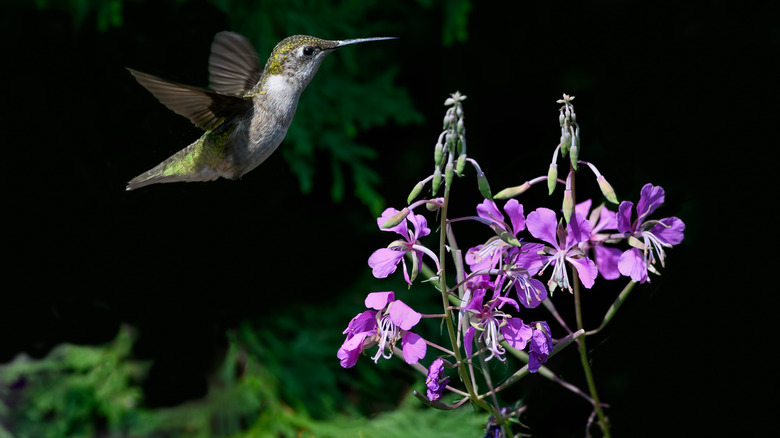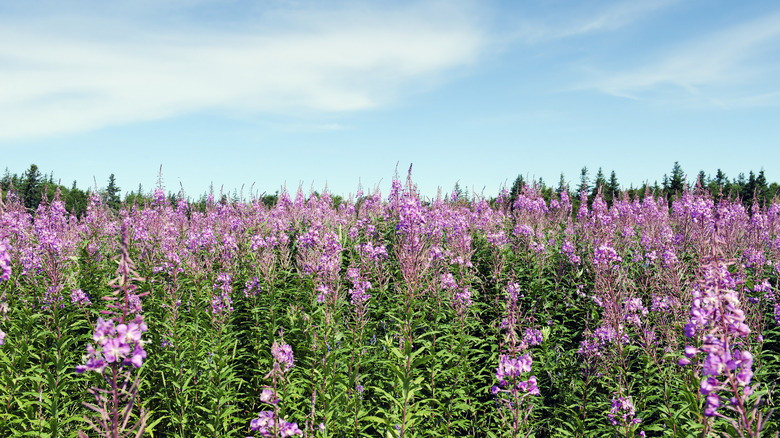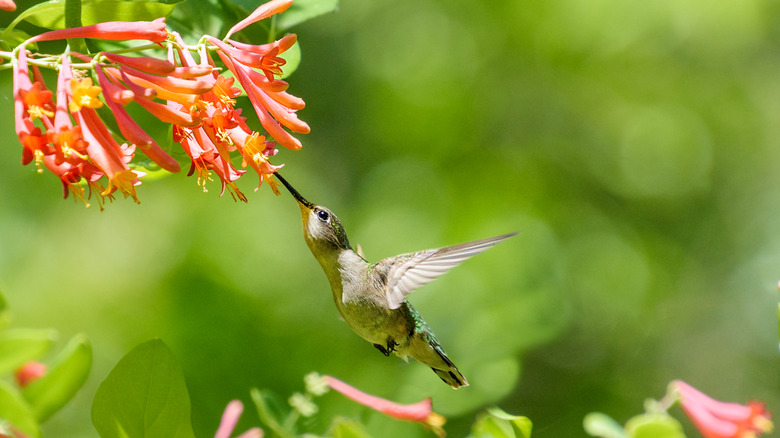Yes, You Can Attract Hummingbirds By Growing Fireweed, But Is It A Good Idea?
Growing a garden is a rewarding way to create a stunning backyard while giving back to the ecosystem. There are several flowers that hummingbirds absolutely love; however, this doesn't mean every pollinator-attracting plant species is the best choice. To attract hummingbirds to your garden, you'll want vibrantly colored tube-shaped blooms growing so they can easily stop by and have a drink. With that in mind, it may seem like fireweed (Chamerion angustifolium) fits all the criteria. Fireweed features tall stalks of gorgeous, vibrant blooms that are attractive to several pollinators. So, what's the catch?
Although gorgeous and nectar-rich, these plants are known for their ability to grow and spread rapidly, quickly colonizing open areas. In fact, fireweed gets its name from how well it's able to colonize areas burned by fire. This expert colonizer was one of the first plants to grow after the 1980 eruption of Mount St. Helens. These flowers spread by rhizomes and self-seeding, with each plant producing up to a whopping 80,000 seeds. Each of the tiny seeds has silky hairs on the end that make it quite literally a breeze for the wind to transport them far away from the main plant. When left unattended, they can quickly take over the garden.
What is the best way to grow fireweed in the garden?
Although it's not generally considered invasive, it may not be the most ideal companion plant for other flowers in your garden. Despite this, it can be hard to resist its charm. While planting fireweed isn't the best idea due to its vigorous growth habit, it's also not the worst considering it's a native species. Growing an average of 4 to 6 feet in height, these tall stalks of flowers add a lot of visual interest as well as convenient food for pollinators. If you want to keep invasive plants from spreading in your garden, consider using planters rather than sticking them where their rhizomes can take over. You can even bury the containers so these flowers can grow in the same bed as the other plants without risking their aggressive spread.
Fireweed thrives in full sun to partial shade in well-draining soil and prefers neutral-acidic soil. Although it can be relatively drought-tolerant once established, it's a good idea to give it regular moisture during growth and good watering during dry periods. When given the proper conditions, you'll be able to enjoy the showy pinkish-purple blooms through spring and summer. In winter, the plant may die back, though it'll regrow through the previous year's roots once it warms up again. Adding mulch for insulation during the extreme cold temperatures can aid in overwintering.
Garden-friendly alternative that will attract hummingbirds
While fireweed isn't the most aggressive spreader, it can still be a lot to manage. Luckily, there are several other plants for your pollinator garden that hummingbirds won't be able to resist. Trumpet honeysuckle (Lonicera sempervirens) is a stunning flowering vine that features showy, trumpet-shaped flowers against glossy and smooth blue-green leaves. As summer fades to fall, bright red berries appear that are the perfect snack for several bird species like quail, American robins, purple finches, and hermit thrushes. The best part? This stunning plant is native to North America and is a non-invasive species. It's considered to be a moderately vigorous grower, making it eco-friendly and easier to manage.
Trumpet honeysuckle loves well-drained, neutral to acidic soil and prefers medium moisture. While it can tolerate a bit of shade, it thrives when planted in a location with full sun. Although it boasts stunning flowers around mid-spring, don't expect them to be fragrant. You can grow this beauty in several ways, depending on your preferred garden design. Because it's a vine, you can allow it to travel up support structures like a fence or trellis. However, you can also let it grow as a ground cover, though you'll have to keep up with the spread a bit. Each plant can grow up to 20 feet tall and 6 feet wide, so make sure you have plenty of space to let it do its thing.


